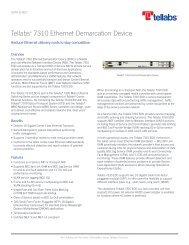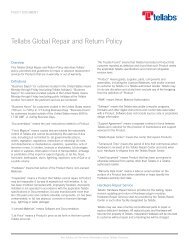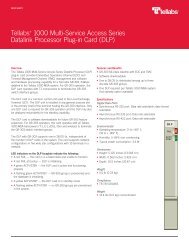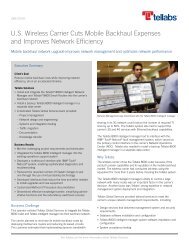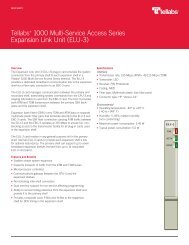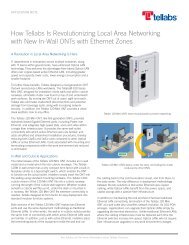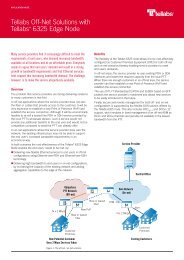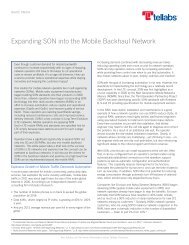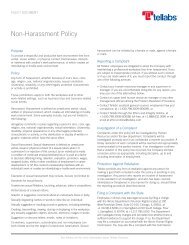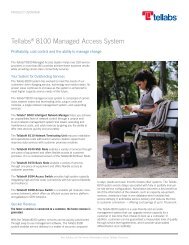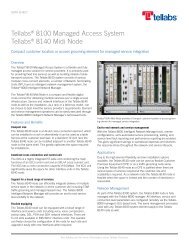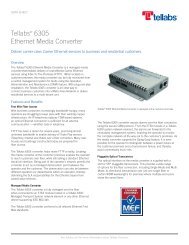Create successful ePaper yourself
Turn your PDF publications into a flip-book with our unique Google optimized e-Paper software.
1 st Q U A R T E R 2 0 1 0<br />
Innovations to<br />
help you succeed<br />
Upload:<br />
60% of Latin<br />
America<br />
Going Optical<br />
NetCom<br />
Lights Up<br />
LTE<br />
<strong>Tellabs</strong>’ Ethernet solution<br />
keeps Nordic operator’s<br />
4G backhaul costs<br />
at 3G levels<br />
inside<br />
Smartphones Make<br />
Networks Wise Up<br />
Analyst Outlook for 2010<br />
Verizon Takes<br />
VPLS Inside<br />
Mobile World<br />
Congress and CTIA<br />
Wireless Previews<br />
Tore Malmo,<br />
manager of<br />
transmission<br />
networks at<br />
NetCom
leading edge<br />
Solving your business challenges<br />
Helping you succeed with mobile Internet<br />
User demand for mobile Internet is booming. That increases<br />
bandwidth consumption, drives up costs and pressures margins.<br />
Customers tell us that mobile data traffic is growing 30% to<br />
50% a year. We want to help you succeed as you prepare 3G and<br />
4G networks to deliver mobile Internet, video and commerce.<br />
Offering the unique new SMARTCORE gateway<br />
In December, <strong>Tellabs</strong> closed our acquisition of WiChorus and<br />
its breakthrough mobile packet core gateway. The WiChorus<br />
acquisition expands <strong>Tellabs</strong> ® Mobile Solutions beyond mobile<br />
backhaul into adjacent applications, so you can:<br />
n deliver rich, differentiated user experiences on the mobile<br />
Internet<br />
n launch new applications to generate revenue<br />
n<br />
n<br />
monetize over-the-top content<br />
simplify networks to achieve significant savings.<br />
The WiChorus gateway is the only currently available packet<br />
core platform that’s purpose-built for 4G, LTE and WiMAX,<br />
with support for 3G. It includes a full range of mobile IP<br />
products, ranging from low entry price to highly scalable, for<br />
applications including GGSN, LTE and WiMAX.<br />
Monetize the top 400 mobile<br />
Internet applications<br />
The WiChorus gateway:<br />
n offers 8 times more throughput, 4 times more simultaneous<br />
Internet connections and active users, compared with competitive<br />
platforms<br />
n uniquely combines world-class application analytics with a<br />
mobile core gateway for improved traffic engineering and<br />
network optimization<br />
n enables service providers to analyze and monetize more than<br />
400 of the top mobile Internet applications<br />
n makes mobile networks content-aware and context-aware,<br />
with personalized application-awareness<br />
n outperforms other platforms in delivering mobile Internet<br />
capacity with superior deep-packet inspection (DPI)<br />
capability<br />
n delivers new and differentiated applications, such as Internet<br />
offload and distributed LTE gateway, to improve the user<br />
experience, increase core network efficiency up to 70% and<br />
reduce capital expenses up to 50%.<br />
Focused on mobility<br />
This <strong>issue</strong> of Inspire focuses on mobile networks and the mobile<br />
Internet. In our cover story, see how Netcom is transforming its<br />
network to become a 4G leader, using <strong>Tellabs</strong> ® Mobile Solutions<br />
(pages 6-8).<br />
Also in this <strong>issue</strong>, our chief technology officer Vikram Saksena<br />
shares his insights on the future of mobility (pages 13-14). We<br />
add to Vikram’s vision the viewpoints of leading industry analysts<br />
(pages 10 and 15).<br />
Hope to see you at MWC and CTIA Wireless<br />
We’ll share more about <strong>Tellabs</strong>’ mobile vision, ideas and expanded<br />
solutions at Mobile World Congress (MWC) in Barcelona,<br />
booth # 2A47, on Feb. 15-18. And at the CTIA Wireless 2010<br />
show in Las Vegas on March 23-25. I hope to see you there!<br />
The WiChorus<br />
gateway is the<br />
only currently<br />
available packet<br />
core platform<br />
that’s purposebuilt<br />
for 4G, LTE<br />
and WiMax, with<br />
support for 3G.<br />
Robert W. Pullen<br />
<strong>Tellabs</strong> CEO and President<br />
Robert W. Pullen<br />
CEO and President<br />
2 <strong>Tellabs</strong> Inspire • 1 st QUARTER 2010
contents<br />
tellabs<br />
One <strong>Tellabs</strong> Center<br />
1415 West Diehl Road<br />
Naperville, IL 60563 USA<br />
Phone: +1.630.798.8800<br />
Fax: +1.630.798.2525<br />
www.tellabs.com<br />
President and CEO<br />
Robert W. Pullen<br />
Editorial Managers<br />
George Stenitzer<br />
Ted Meister<br />
inspire@tellabs.com<br />
Published by<br />
Telephony Custom Media<br />
330 North Wabash Avenue<br />
Suite 2300<br />
Chicago, IL 60611<br />
Phone: +1.312.595.1080<br />
Fax: +1.312.595.0296<br />
www.telephonyonline.com<br />
Editor<br />
Tim Kridel<br />
Editorial Contributors<br />
Joan Engebretson, Lynnette Luna,<br />
Patrick Donegan and Vikram Saksena<br />
Art Direction<br />
Cavedweller Studio<br />
Account Manager<br />
Bethany Borger<br />
Reprints<br />
For reprints and e-prints, call<br />
FosteReprints at +1.866.436.8366<br />
4 Upload<br />
Most Latin American networks<br />
go optical by 2014. Broadband<br />
becomes a human right. And more.<br />
6 Gateway to the<br />
Mobile Future<br />
A sneak peek at <strong>Tellabs</strong>’ lineup<br />
for Mobile World Congress<br />
and CTIA Wireless.<br />
By Tim Kridel<br />
7 Just Wait ’Til This Year<br />
Five top analysts share their<br />
outlook for 2010 and beyond.<br />
By Tim Kridel<br />
8 NetCom’s LTE Leap<br />
Scandinavian operator uses Ethernet<br />
to get 4G backhaul for the price of 3G.<br />
By Lynnette Luna<br />
11 Verizon’s Inside Job<br />
Verizon upgrades its internal<br />
data network with VPLS and the<br />
<strong>Tellabs</strong>® 8800 Multiservice Router.<br />
By Joan Engebretson<br />
13 Smartphones Need<br />
Smart Networks<br />
Savvy operators know that smart<br />
networks are key to making<br />
money from smartphones.<br />
By Vikram Saksena<br />
15 Surfing the Mobile Wave<br />
To avoid being swamped, mobile<br />
operators must focus on IP,<br />
IT and Internet partners.<br />
By Patrick Donegan<br />
cover photo by Jørn tomter / getty images<br />
Statements herein may contain projections<br />
or other forward-looking statements<br />
regarding future events, products, features,<br />
technology and resulting commercial or<br />
technological benefits and advantages.<br />
These statements are for discussion<br />
purposes only, are subject to change and are<br />
not to be construed as instructions, product<br />
specifications, guarantees or warranties.<br />
Actual results may differ materially.<br />
The following trademarks and service<br />
marks are owned by <strong>Tellabs</strong> Operations,<br />
Inc., or its affiliates in the United States<br />
and/or other countries: TELLABS®,<br />
TELLABS and T symbol®, and T symbol®.<br />
Any other company or product names may<br />
be trademarks of their respective companies.<br />
Copyright © 2010 <strong>Tellabs</strong>.<br />
All rights reserved.<br />
74.2128E<br />
Read or subscribe to<br />
<strong>Tellabs</strong> Inspire online:<br />
www.tellabs.com/news/inspire<br />
1 st QUARTER 2010 • <strong>Tellabs</strong> Inspire 3
AFCEA West<br />
February 2-4<br />
San Diego, USA<br />
upload<br />
Mobile World<br />
Congress<br />
February 15-18<br />
Barcelona, Spain<br />
CTIA Wireless<br />
March 23-25<br />
Las Vegas, USA<br />
Most Latin American Networks to<br />
Go Optical by 2014, Survey Finds<br />
In Latin America, the future of telecom<br />
networks is clear – literally. By the end<br />
of 2014, more than 60% of the region<br />
will have upgraded to optical, according<br />
to a survey of attendees at Futurecomm<br />
’09 in São Paulo, Brazil.<br />
Conducted by <strong>Tellabs</strong> and IDC, an<br />
independent research firm, the survey<br />
found that improved speed and capacity<br />
are the main reasons why most of the<br />
region’s network infrastructure will go<br />
optical over the next five years. Nearly<br />
half of respondents cited cost savings as<br />
the next major reason, followed by simplified<br />
network management (33%).<br />
The region’s optical overhaul is a<br />
major undertaking. More than 40% of<br />
respondents said that less than 15% of<br />
their network infrastructure is optical<br />
today. Within five years, 39% predict<br />
more than 75% of network infrastructure<br />
will be optical, and more than<br />
60% foresee half of their networks<br />
being optical.<br />
SDH/SONET currently is the<br />
region’s most widely used technology,<br />
at 39%, but Carrier Ethernet is a close<br />
second. By 2014, Carrier Ethernet will<br />
dominate, followed by DWDM. Only<br />
14% of respondents believe they’ll still<br />
be using SDH/SONET in five years.<br />
“The survey respondents clearly<br />
understand that operators in Brazil have<br />
infrastructure <strong>issue</strong>s that need to be<br />
solved quickly,” said Vinicius Caetano,<br />
a telecom analyst at IDC. “Operators<br />
must invest in highly cost-efficient and<br />
scalable solutions to be ready for the<br />
inevitable demand increase.”<br />
The region’s preference for green<br />
networks also is driving the optical<br />
trend. More than<br />
90% of respondents<br />
said it’s important to<br />
lower network power<br />
consumption, and<br />
33% cited reduced<br />
energy consumption<br />
as one of the reasons why the region’s<br />
network infrastructure will go optical.<br />
“The findings of this survey reveal<br />
that telecom professionals in Brazil<br />
understand the tremendous impact<br />
traffic growth will have on networks<br />
in the near term,” said Tarcisio Ribeiro,<br />
vice president of sales for <strong>Tellabs</strong>’<br />
Latin America and Caribbean region.<br />
“Optical networks are the right choice<br />
to improve network capacity, lower<br />
costs and reduce power consumption.”<br />
DWDM: Dense Wave Division Multiplexing SDH: Synchronous Digital Hierarchy SONET: Synchronous Optical Networking<br />
4 <strong>Tellabs</strong> Inspire • 1 st QUARTER 2010
The New Human<br />
Right: Broadband<br />
Mobile Social Networking Gets Rich<br />
There’s a reason why so many smartphones and feature phones now ship with<br />
social networking apps pre-loaded: It’s one of wireless’ fastest-growing services, on<br />
track to surpass $410 million in revenue and 140 million users worldwide by 2013,<br />
according to ABI Research.<br />
But more than 80 wireless carriers and vendors aren’t taking that growth for<br />
granted. Instead, they’ve teamed up with the GSM Association (GSMA) to develop<br />
the Rich Communication Suite (RCS), which aims to make multimedia social networking<br />
easier and richer.<br />
The latest version of the spec, RCS Release 2, enables services such as sharing<br />
photos and videos in the middle of a call. RCS supports presence-enhanced contact<br />
management, so users can tell whether they can reach someone with a video call,<br />
instant message (IM) or voice call. RCS also eliminates the need to remember each<br />
contact’s IM ID by relying on their mobile number instead.<br />
RCS works with technologies such as IP Multimedia Subsystem (IMS), making<br />
RCS-based services available on both mobile phones and wired PCs, as well as<br />
CDMA networks. That flexibility complements the growing number of telco and<br />
cable quadruple plays (wireline voice, broadband, wireless and video).<br />
At Mobile World Congress 2009, several panels covered RCS. (The videos<br />
are available at www.gsmworld.com/our-work/mobile_lifestyle/rcs/videos.htm.)<br />
Since then, three South Korean operators – LG Telecom, KT and SK Telecom<br />
– launched the world’s first commercial RCS services. By the end of this year,<br />
1.3 million consumers worldwide will be using RCS-based services, Infonetics<br />
Research predicts. Put all of that together, and it’s a safe bet that RCS will be one of<br />
the hot topics at Mobile World Congress 2010.<br />
In many countries, Internet access is<br />
rapidly evolving from a nice-to-have to a<br />
must-have. Estonia, Finland, France and<br />
Greece have declared it a human right<br />
for their citizens, while Spain is considering<br />
it. And the United Nations has spent<br />
the past few years arguing that it should<br />
be a right for everyone, everywhere.<br />
Finland recently went a step further,<br />
mandating the minimum speed – 1 Mbps<br />
– that all broadband providers must deliver.<br />
The country’s Ministry of Transport<br />
and Communications plans to increase<br />
the minimum to 100 Mbps by 2015.<br />
Some countries already have speed<br />
requirements, but only for certain<br />
deployments rather than all operators.<br />
For example, the U.S. broadband stimulus<br />
package will fund a network only if it<br />
supports at least 768 kbps.<br />
A country’s throughput requirements<br />
are worth noting because they affect the<br />
amount of money that each service provider<br />
has to spend – not just to meet those<br />
minimums, but to exceed them by a margin<br />
big enough to stand out in the market<br />
and justify a price premium. Throughput<br />
requirements also affect the types of<br />
broadband services that can be offered in<br />
a country. For example, it’s tough to sell<br />
high-definition movie downloads in a<br />
market where most users have a relatively<br />
slow connection.<br />
Internet-Ready TVs Shake Up the Video Market<br />
If you buy a TV this year, there’s a good<br />
chance that it will have built-in Internet<br />
connectivity. Major vendors such as<br />
Panasonic, Samsung and Sony already<br />
offer several models of Web-ready TVs,<br />
and by 2013, they’ll be 36% of new TV<br />
sales, according to a recent report by<br />
In-Stat, an independent research firm.<br />
Adoption will skyrocket in some<br />
markets. In the U.S., for example,<br />
Web TVs will grow from about 1%<br />
of all TVs sold in 2008 to about 14%<br />
in 2012, predicts Parks Associates, a<br />
research firm.<br />
For cable operators and telco TV<br />
providers, the trend is both a problem<br />
and an opportunity. As the selection of<br />
online video programming grows, some<br />
subscribers will drop their cable and<br />
telco video packages. But on the plus<br />
side, they’ll still need a broadband connection,<br />
and they might have to upgrade<br />
to a faster service plan in order to get<br />
decent quality video, let alone HD.<br />
Telcos and cable operators are<br />
already concerned about losing video<br />
customers to PC-based services, where<br />
viewership grew from 32% of American<br />
consumers in 2007 to 63% in 2009,<br />
according to ABI Research. Some are<br />
striking deals with content providers<br />
to mitigate that threat. For example,<br />
Cablevision lets its broadband customers<br />
watch the YES sports network online<br />
only if they’re also TV subscribers.<br />
1 st QUARTER 2010 • <strong>Tellabs</strong> Inspire 5
mwc and ctia<br />
Gateway to the<br />
Mobile Future<br />
The Mobile World Congress and CTIA<br />
Wireless shows are just around the<br />
corner. Here’s what to expect.<br />
By Tim Kridel<br />
This year’s Mobile World<br />
Congress and CTIA<br />
Wireless shows should<br />
provide a good barometer<br />
of the mobile industry’s<br />
present and future.<br />
Held February 15-18 at the Fira de<br />
Barcelona at Montjuic in Barcelona,<br />
Spain, the 2010 Mobile World Congress<br />
will feature more than 1,300 companies,<br />
including <strong>Tellabs</strong>, which will be in exhibit<br />
No. 2A47.<br />
Vikram Saksena, <strong>Tellabs</strong> chief technology<br />
officer, will speak at MWC on the<br />
topic of cloud computing.<br />
“It is, by far, the premier mobile<br />
industry event for <strong>Tellabs</strong>,” said Sonny<br />
Waheed, senior manager, communications<br />
for EMEA and Asia-Pacific. “It’s<br />
an ideal opportunity to showcase our<br />
leading-edge solutions and engage with<br />
the mobile world.”<br />
What’s New<br />
<strong>Tellabs</strong> will use Mobile World Congress to<br />
showcase mobile, optical<br />
and business solutions,<br />
as well as professional<br />
services. The first is<br />
covered by the <strong>Tellabs</strong> ®<br />
Mobile Solutions portfolio,<br />
which helps mobile<br />
operators reduce the<br />
cost of both 3G and 4G.<br />
(For one example, see<br />
“NetCom’s LTE Leap”<br />
on page 8 of this <strong>issue</strong>.)<br />
“<strong>Tellabs</strong> Mobile Solution now expands<br />
from 3G and 4G mobile backhaul into<br />
mobile packet core applications. We can<br />
help carriers improve the mobile Internet<br />
experience, deliver new revenue-generating<br />
applications and achieve significant<br />
savings.” Waheed said.<br />
<strong>Tellabs</strong> will showcase breakthrough<br />
packet core technology from WiChorus,<br />
acquired late in 2009. The world’s only<br />
packet core platform that’s purpose-built<br />
for 4G LTE and WiMAX, with support<br />
for 3G, it handles 8 times more throughput<br />
and 4 times more simultaneous<br />
Internet connections than other platforms.<br />
(See “Leading Edge,” page 2.)<br />
North American and African customers<br />
are using <strong>Tellabs</strong> Optical Solutions<br />
to slash backhaul costs, even as they<br />
increase backhaul capacity in order to<br />
support bandwidth-intensive services<br />
such as video.<br />
“Optical can cut capital expenses up<br />
to 65%, while reducing power consumption<br />
by the same amount,” Waheed said.<br />
“The same platform can also deliver<br />
business services.”<br />
As the selection of products and technologies<br />
grows, so does the challenge of<br />
choosing the right ones. That’s where the<br />
third main area comes in: <strong>Tellabs</strong> ® Global<br />
Services, which provides mobile operators<br />
“Our Network Performance<br />
Management service<br />
provides visibility into the<br />
mobile data users’ experience<br />
throughout the network.”<br />
Sonny Waheed, senior manager, communications<br />
for EMEA and Asia-Pacific<br />
with on-site experts to help plan, build<br />
and optimize networks, including LTE.<br />
“Our Network Performance Management<br />
service provides visibility into the<br />
mobile data users’ experience throughout<br />
the network,” Waheed explained. “It provides<br />
service providers with deeper levels<br />
Mobile World Congress<br />
- Exhibit 2A47<br />
of information, so they can make smarter<br />
network decisions and proactively resolve<br />
<strong>issue</strong>s before they affect customers.”<br />
Adding Value — in More<br />
Ways than One<br />
Held March 23-25 in Las Vegas, CTIA<br />
Wireless is the next major opportunity<br />
to learn more about the evolution of the<br />
<strong>Tellabs</strong> ® Mobile Solutions portfolio. At<br />
both shows, <strong>Tellabs</strong> will forego the trade<br />
show tradition of loading up booth visitors<br />
with USB memory sticks, pens and<br />
tote bags.<br />
Instead, <strong>Tellabs</strong> is offering attendees an<br />
opportunity to help several charities.<br />
We will donate to charities of our customers’<br />
choosing the same money we<br />
might have spent on giveaways – roughly<br />
$30,000-$35,000 – and donate it to charity,”<br />
Waheed said. “Everybody who comes<br />
to our exhibit will be encouraged to go to<br />
a touchscreen, where there’s information<br />
about three different charities, such as<br />
Doctors Without Borders and Oxfam<br />
International. They can vote for their<br />
favorite charity.”<br />
The charity with the most votes<br />
receives $15,000. The next one gets<br />
$10,000, and the third $5,000. It’s part of<br />
the <strong>Tellabs</strong> Foundation, which awarded<br />
nearly $1 million in 2008 to organizations<br />
such as the American Cancer Society<br />
and Save the Children. The opportunity<br />
to help shape 2010 donations is yet<br />
another reason to attend CTIA Wireless<br />
and Mobile World Congress. n<br />
3G: Third-Generation 4G: Fourth-<br />
Generation CapEx: Capital Expenses<br />
LTE: Long Term Evolution<br />
6 <strong>Tellabs</strong> Inspire • 1 st QUARTER 2010
analyst viewpoint<br />
Just Wait ’Til This Year<br />
Telecom isn’t recession-proof, but it fared relatively well in 2009.<br />
Five top analysts share their outlook for 2010 and beyond.<br />
By Tim Kridel<br />
Despite the worst economy<br />
in 70 years, some<br />
parts of the telecom<br />
market not only survived<br />
the past year, but<br />
thrived. That good news, along with the<br />
outlook for this year and beyond, were<br />
among the topics that analysts discussed<br />
at the 2009 <strong>Tellabs</strong> analyst conference,<br />
held Sept. 15-16.<br />
Following are some highlights from<br />
those conversations. For each analyst’s<br />
full Q&A, visit www.tellabs.com/<br />
news/inspire.<br />
Michael Howard, principal analyst<br />
and co-founder at<br />
Infonetics Research:<br />
One thing that has<br />
not gone down during<br />
the downturn is<br />
bandwidth use. People<br />
keep using more.<br />
What carriers have<br />
been doing is prepare<br />
their networks for the next 10 years.<br />
Everybody’s being more mobile, so<br />
they’re adding mobility. They’re also preparing<br />
their networks for IP. Over a long<br />
period of time, the old TDM networking<br />
layer will go away, the SONET and<br />
SDH layer. Networks will become more a<br />
transport layer of Ethernet and WDM.<br />
Warren Chaisatien,<br />
research director<br />
at Telsyte: One of<br />
the most significant<br />
trends that I can<br />
see now is the rise<br />
of consumer cloud<br />
computing. You and I are now starting to<br />
feel very comfortable posting and sharing<br />
our personal digital content online in a<br />
cloud, allowing our friends and family and<br />
perhaps colleagues to access our personal<br />
pictures, videos, blogs and other files.<br />
That will be driving tremendous shifts<br />
from a carrier perspective.<br />
It will revolutionize the way service<br />
providers position themselves. Instead of<br />
providing dumb pipe access to the content,<br />
they will have to add intelligence<br />
into the network and add a personalized<br />
service to consumers.<br />
Ron Kline, research<br />
director at Ovum:<br />
Ethernet is really<br />
becoming the new<br />
network currency as<br />
we transition from<br />
SONET SDH to a<br />
more packet-oriented<br />
world, with Ethernet as the multiplex<br />
layer. In the core of the network, we’re<br />
seeing this transition to OTN switching<br />
because of the transparency it provides in<br />
switching: not only traditional SONET<br />
SDH, but also the emerging Ethernettype<br />
services, as well as other storage<br />
area-type protocols.<br />
As we get better at making Ethernet<br />
more predictable and acting like traditional<br />
SONET SDH with all the OA&M<br />
capabilities and such, we’ll start to see<br />
that adoption really ratchet up. That’s<br />
because it’s a more cost-effective method<br />
for connecting to the network for not<br />
only enterprises, but internal networks,<br />
as well, both wireline and wireless.<br />
Sterling Perrin, senior<br />
analyst at Heavy<br />
Reading: The most<br />
disruptive trend we’re<br />
seeing is the growth<br />
of packet optical<br />
transport. At the<br />
highest level, we’re<br />
seeing three different approaches: IP<br />
over DWDM; carrier Ethernet switches,<br />
which can be combined with an optical<br />
layer; and a converged system, “packet<br />
optical transport systems,” which combine<br />
a WDM layer with SONET and<br />
SDH transport, as well as high-capacity<br />
Ethernet switching and increased control<br />
plane technology on top of that.<br />
We’re tracking very closely the<br />
evolution of the SONET and SDH<br />
infrastructure and the standalone WDM<br />
infrastructure into these new systems. It’s<br />
that trend that we’re really seeing starting<br />
to gather a lot of momentum, especially<br />
in 2009 and into 2010.<br />
Ian Redpath, principal<br />
analyst at Ovum:<br />
At Ovum, we’ve just<br />
gone through looking<br />
at the market from<br />
the second quarter,<br />
2009 point of view,<br />
and North America<br />
and Europe are still<br />
suffering from the recession. But Asia-<br />
Pacific is doing quite well. <strong>Tellabs</strong> has a<br />
good strategy for the Chinese market,<br />
India and Indonesia, and it’s where they<br />
need to be.<br />
Another key thing I learned at this conference<br />
was <strong>Tellabs</strong>’ intention of bringing<br />
a terabit OTN switch to the marketplace.<br />
With <strong>Tellabs</strong>’ strong DNA in the bandwidth<br />
management category, we did<br />
think it was a bit of an inevitability. We’re<br />
pleased that <strong>Tellabs</strong> is moving forward on<br />
that particular product front. n<br />
OA&M: Operations, Administration<br />
and Maintenance OTN: Optical<br />
Transport Network DWDM:<br />
Dense Wave Division Multiplexing<br />
SDH: Synchronous Digital<br />
Hierarchy SONET: Synchronous<br />
Optical Networking TDM: Time<br />
Division Multiplexing WDM:<br />
Wave Division Multiplexing<br />
For more insights into the<br />
cloud computing opportunity for<br />
service providers, see “Clouds<br />
in the Forecast,” available in the<br />
December 2008 <strong>issue</strong> of Inspire at<br />
www.tellabs.com/news/inspire<br />
1 st QUARTER 2010 • <strong>Tellabs</strong> Inspire 7
cover story: netcom<br />
NetCom’s<br />
By Lynnette Luna<br />
LTE<br />
Leap<br />
One of<br />
Scandinavia’s<br />
largest mobile<br />
operators<br />
leverages <strong>Tellabs</strong>’<br />
Ethernet solution<br />
to keep 4G<br />
backhaul costs<br />
at 3G levels.<br />
It’s no secret that the world’s mobile<br />
operators are witnessing an insatiable<br />
demand for broadband among<br />
their subscribers. Faster 3G networks,<br />
coupled with competitive<br />
service pricing, compelling smartphones<br />
and connected laptops, have come<br />
together to create the perfect storm for<br />
the mobile broadband business.<br />
This situation is highlighted in the<br />
Nordic region, where sophisticated users<br />
set trends that eventually play out in<br />
the rest of the world’s mobile markets.<br />
The region’s mobile voice penetration<br />
exceeded 100% years ago. Now, operators<br />
in Denmark, Norway and Sweden<br />
have turned to mobile broadband services<br />
for new market-differentiation and<br />
revenue opportunities.<br />
The race is on to develop the next<br />
wave of compelling services. Those services<br />
hinge on next-generation networks<br />
that are capable of transmitting multimegabit<br />
speeds on the go – and doing so<br />
on a significantly lower cost-per-bit basis<br />
than today’s 3G and 3.5G networks.<br />
Nordic powerhouse TeliaSonera is<br />
in the process of building one of the<br />
world’s first LTE networks in Oslo and<br />
Stockholm, targeting a commercial<br />
launch in 2010. Why those two markets?<br />
One reason is because subscribers<br />
there are demanding higher bandwidth.<br />
Another is because Norway and Sweden<br />
were among the first countries to auction<br />
4G licenses last spring in the 2.6 GHz<br />
band, the spectrum that’s being set aside<br />
worldwide for 4G networks.<br />
TeliaSonera was the first operator<br />
to publicly award LTE pilot<br />
network contracts: one with Ericsson<br />
for the Stockholm market and one with<br />
Huawei Technologies for Oslo, where<br />
TeliaSonera’s mobile arm, NetCom, with<br />
some 1.2 million subscribers, is fighting<br />
hard for market share against the incumbent<br />
operator, Telenor.<br />
Mobile voice penetration in Norway<br />
reached 110% in early 2009, according<br />
to BuddeComm, an independent<br />
research firm. While overall subscriber<br />
growth has fallen to about 1.5%, the 3G<br />
sector has experienced robust growth,<br />
BuddeComm said. And if competition<br />
weren’t stiff enough already, a new 3G<br />
provider, Mobile Norway, is set to launch<br />
commercial service.<br />
“We are the challenger in Norway,”<br />
said Torstein Aars, department manager<br />
of network development at NetCom.<br />
“It’s important to be on the forefront of<br />
innovation. That is the driver for 4G. We<br />
are constantly working to come up with<br />
new services so that we can be consistently<br />
on the edge.”<br />
Nearly Free Bandwidth<br />
Indeed, LTE promises data speeds that<br />
will make most of today’s fixed-line<br />
broadband connections seem lethargic. In<br />
June 2009, NetCom showcased live LTE<br />
services that included applications such<br />
as video on demand, streaming video, file<br />
transfers, Web surfing, videoconferencing<br />
and video telephony, all under real<br />
network conditions. The network will be<br />
able to deliver download peak data rates<br />
of up to 150 Mbps in one LTE cell with<br />
multiple terminals.<br />
“What we have learned so far from<br />
these test results is very impressive<br />
around data speeds,” Aars said.<br />
NetCom will hold an advantage in<br />
terms of understanding the real-world<br />
8 <strong>Tellabs</strong> Inspire • 1 st QUARTER 2010
Photos by Jørn Tomter / Getty Images<br />
capabilities of LTE early on, Aars said.<br />
And most importantly, in deploying<br />
LTE, NetCom plans to see a reduction<br />
in OpEx rather than the increase that<br />
usually comes with the deployment of a<br />
new network technology.<br />
Recognizing the unpredictable growth<br />
associated with the WCDMA/HSPA<br />
data traffic, NetCom embarked on a<br />
plan in 2009 to change its approach to<br />
the management of its 2G and 3G/3.5G<br />
networks. A major part of that change<br />
involved working with <strong>Tellabs</strong> to invest in<br />
Ethernet as a new backhaul solution – not<br />
only to manage the new world of mobile<br />
broadband but also to reduce costs associated<br />
with backhauling 2G traffic.<br />
NetCom is rolling out Ethernet transport<br />
for its 2G and 3G networks, and<br />
preparing to run LTE over the same<br />
Ethernet infrastructure.<br />
“This is a huge OpEx saver,” said Tore<br />
Malmo, manager of transmission networks<br />
at NetCom. “We can now move<br />
everything to the same solution and<br />
reduce the OpEx.”<br />
Over three months in late 2009,<br />
NetCom doubled its total transmission<br />
Robert Halvorsen,<br />
senior transmission<br />
planner with NetCom<br />
capacity in the radio access<br />
network by implementing<br />
capacities up to 150 Mbps at<br />
a number of sites, in preparation<br />
for LTE, Malmo said.<br />
But that capacity didn’t come<br />
at a price.<br />
“The insignificant increase<br />
in OpEx resulting from this<br />
capacity increase is clear<br />
evidence that we have succeeded<br />
in breaking the bond<br />
between capacity and costs.<br />
“We can’t see any effect on<br />
the OpEx,” Malmo said.<br />
Such results are key if<br />
LTE is to reach its promise<br />
of delivering multi-megabit<br />
services at a significantly<br />
lower cost per bit than today’s<br />
3G/3.5G technologies, said<br />
Tarcisio Ribeiro, vice president<br />
of Europe, Middle East<br />
and Africa sales at <strong>Tellabs</strong>.<br />
“Operators simply must<br />
break that linear relationship<br />
that has always existed between<br />
bandwidth and cost and revenue per<br />
bit,” he said.<br />
1 Gbps Per Base Station<br />
On the air interface side, LTE holds significant<br />
cost-savings promise because<br />
of a more efficient network architecture,<br />
said Pyramid Research analyst<br />
Daniel Locke.<br />
“LTE promises to change the dynamics,<br />
by lowering operating costs not only<br />
because of a simpler network architecture<br />
with fewer network controllers to manage<br />
but also because of enhanced spectral<br />
efficiency, reduced OpEx and a concerted<br />
push to lower intellectual property costs<br />
to a single-digit percentage of the value<br />
of handset sales,” he said.<br />
Equally important, however, is an<br />
operator’s ability to efficiently backhaul<br />
the massive data traffic that will be deluging<br />
LTE base stations. The maximum<br />
throughput of LTE will be limited by the<br />
backhaul capacity of the cell site that the<br />
user is connected to.<br />
Analysts estimate that each LTE base<br />
station must be capable of handling<br />
bandwidth in the range of 100 Mbps to<br />
300 Mbps. As demand skyrockets, that<br />
number could reach 1 Gbps or more.<br />
That type of bandwidth will break the<br />
bank under the traditional network backhaul<br />
regime of E1s and T1s. Just one or<br />
two E1 lines are required to backhaul<br />
voice traffic today. By most estimates,<br />
backhaul traditionally accounts for about<br />
30% of an operator’s OpEx.<br />
Throw broadband traffic in the mix,<br />
and the requirement skyrockets to a<br />
dozen or more E1 lines. At hundreds<br />
of dollars per line, per month, such a<br />
deployment scenario makes no economic<br />
sense, said NetCom’s Malmo.<br />
“Without the <strong>Tellabs</strong> solutions, we<br />
wouldn’t be able to support our 4G<br />
deployment and also increase capacity<br />
on the HSPA side without dramatically<br />
increasing OpEx,” Malmo said.<br />
NetCom is using the <strong>Tellabs</strong> ® 8600<br />
“This is a huge OpEx saver.<br />
We can now move everything to the<br />
same solution and reduce the OpEx.”<br />
Tore Malmo, manager of transmission networks at NetCom<br />
Managed Edge System (MES), part<br />
of <strong>Tellabs</strong>’ Mobile Solutions suite of<br />
products, which uses Pseudowire over<br />
MPLS as a cost-effective alternative to<br />
buying more E1s. NetCom is replacing<br />
its E1s by using the <strong>Tellabs</strong> equipment<br />
to produce its own bandwidth on top<br />
of leased Ethernet capacity, said Robert<br />
Halvorsen, senior transmission planner<br />
with NetCom.<br />
Ethernet is a much less expensive and<br />
more flexible technology than TDM<br />
technology, which is the basis of E1 lines.<br />
Ethernet also supports high-bandwidth<br />
scalability that can be used on an incremental<br />
basis, with carriers paying only<br />
for what they use.<br />
2G: Second-Generation 3G: Third-Generation ATM: Asynchronous Transfer Mode CapEx: Capital Expenses HSPA: High-<br />
Speed Packet Access IP: Internet Protocol LTE: Long Term Evolution MPLS: Multiprotocol Label Switching OpEx: Operating<br />
Expenses TDM: Time Division Multiplexing WCDMA: Wideband Code Division Multiple Access<br />
1 st QUARTER 2010 • <strong>Tellabs</strong> Inspire 9
cover story: netcom<br />
Anders Grand (left),<br />
Robert Halvorsen<br />
“We are the challenger<br />
in Norway. It’s important<br />
to be on the forefront<br />
of innovation.”<br />
Torstein Aars, department manager of<br />
network development at NetCom<br />
Photo by Jørn Tomter / Getty Images<br />
“For NetCom, that translates into<br />
simplicity,” said Anders Grand, <strong>Tellabs</strong><br />
account manager for NetCom. “Instead<br />
of leasing capacity for each mobile service<br />
– 2G, 3G/3.5G and 4G – NetCom<br />
can use one single installation and the<br />
2G, 3G and HSPA travels at no additional<br />
cost to them.”<br />
Indeed, Halvorsen noted that the average<br />
capacity NetCom supports today in<br />
its 3G base stations can be expanded<br />
fivefold without increasing the operator’s<br />
OpEx. That capability is especially<br />
important as traffic on the HSPA network<br />
continues to grow at the same time<br />
NetCom rolls out LTE, and NetCom<br />
won’t be exposed to the escalating costs<br />
associated with the demand for bandwidth<br />
on its HSPA network.<br />
Brave New World<br />
Analysts predict that as early as next year,<br />
data traffic will surpass voice traffic on<br />
mobile networks. One reason is because<br />
bandwidth-hogging services such as<br />
video are eating up capacity.<br />
YouTube, for example, says that<br />
mobile video is an “exponentially” growing<br />
part of its site’s usage. In June 2009,<br />
it reported that over a six-month period,<br />
uploads from mobile phones to YouTube<br />
increased 1700%, thanks to the proliferation<br />
of video-enabled mobile devices.<br />
But for NetCom, those trends are<br />
opportunities to drive additional revenue,<br />
instead of just reasons to shell out more<br />
money for backhaul. With the <strong>Tellabs</strong> ®<br />
8600 MES, NetCom also can dynamically<br />
allocate bandwidth from base station to<br />
base station remotely, as demand dictates,<br />
without having to deploy field personnel<br />
– another significant OpEx saver.<br />
NetCom’s backhaul capacity freedom<br />
also puts it in enviable position of being<br />
able to experiment with LTE services, Aars<br />
said. NetCom doesn’t have to worry about<br />
the skyrocketing backhaul costs LTE is<br />
placing on the network as it rolls out a<br />
rather pervasive footprint with increased<br />
capacity yet relatively few customers.<br />
“We need to gain experiences for LTE<br />
and understand how data services will<br />
be adopted across all of the networks,”<br />
Aars said. “But it will really take a while<br />
before we have the same coverage that<br />
we see for 2G. In a country like Norway,<br />
it’s difficult and expensive. What we are<br />
doing is making sure we can produce<br />
an affordable OpEx while pushing new<br />
high-bandwidth services.<br />
“We are moving from the good<br />
stable telco world to a more broadband-based<br />
world. LTE is a big shift in<br />
technology, but then again, that is the<br />
way everyone is moving. You have to<br />
do it sooner or later.” n<br />
$876 Million in OpEx Savings<br />
To address one of Ethernet’s perceived<br />
weaknesses – the inability to carry<br />
TDM-based voice traffic – the <strong>Tellabs</strong>®<br />
8600 MES uses Pseudowire technology.<br />
Created more than a decade ago, the<br />
Pseudowire standard is a building block<br />
upon which multiple types of traffic can<br />
be layered and then converged onto a<br />
single, multipurpose packet-switched<br />
network. In short, Pseudowire technology<br />
emulates the essential attributes<br />
of legacy TDM or ATM service over<br />
a packet network. The technology is<br />
necessary because leaping directly from<br />
TDM to IP and from ATM to Ethernet<br />
isn’t an investment that some operators<br />
want to make right away.<br />
A recent survey of packet backhaul<br />
vendors by the analyst firm Heavy<br />
Reading supports that trend. At the end<br />
of April 2009, fewer than 55,000 2G<br />
or 3G cell sites were in live service with<br />
packet backhaul worldwide, out of a<br />
global total of 2.4 million sites.<br />
The <strong>Tellabs</strong>® 8600 Managed Edge<br />
System (MES) uses Pseudowire over<br />
MPLS as a cost-effective alternative<br />
to buying more E1s or T1s. Based on<br />
feedback from the more than 120<br />
operators that have deployed the<br />
Tarcisio Ribeiro<br />
<strong>Tellabs</strong>® 8600 MES, it’s realistic to<br />
expect a potential savings of 60% to<br />
93% in the evolution from 3G to 4G.<br />
For example, in a 30,000-cell-site<br />
network employing <strong>Tellabs</strong>’ Ethernet<br />
backhaul solution, an operator can save<br />
up to $78 million in CapEx and $876<br />
million in OpEx over five years, said<br />
Tarcisio Ribeiro, vice president-Europe<br />
Middle East Africa sales at <strong>Tellabs</strong>.<br />
10 <strong>Tellabs</strong> Inspire • 1 st QUARTER 2010
verizon idn<br />
Verizon’s Inside Job<br />
Verizon migrates its internal data network to VPLS,<br />
with the <strong>Tellabs</strong> ® 8800 Multiservice Router at the core.<br />
By Joan Engebretson<br />
Like other large corporations,<br />
Verizon needs a<br />
high-capacity data network<br />
to support connectivity to<br />
employee desktops and data<br />
centers. In addition, the carrier’s internal<br />
data network supports command and<br />
control connectivity for the infrastructure<br />
for its wired and wireless networks.<br />
Today, the backbone for Verizon’s<br />
internal data network (IDN) uses private<br />
lines to connect aggregation sites.<br />
But soon the carrier plans to begin<br />
migrating to a backbone network based<br />
on VPLS, which provides multi-point<br />
Layer 2 Ethernet connectivity over<br />
MPLS. Verizon’s MPLS network, initially<br />
deployed several years ago, is based<br />
on the <strong>Tellabs</strong> ® 8800 Multiservice Router<br />
(MSR) series.<br />
Simplicity Equals Savings<br />
Verizon reached a major crossroads in<br />
mid-2009, when it learned that the manufacturer<br />
of certain equipment underlying<br />
its IDN would no longer support that<br />
gear. Verizon had three choices: continue<br />
with a private line approach, use its<br />
MPLS network to support connectivity<br />
via Layer 3 IP VPNs or go VPLS.<br />
“We chose a VPLS or Layer 2-type<br />
network based on its ability to transition<br />
efficiently and effectively at the least<br />
cost,” said Tom Bechly, director of enterprise<br />
network engineering for Verizon<br />
Services Operations.<br />
“We chose a VPLS<br />
or Layer 2-type<br />
network based<br />
on its ability<br />
to transition<br />
efficiently and<br />
effectively at<br />
the least cost.”<br />
Tom Bechly, director of enterprise<br />
network engineering for Verizon<br />
Services Operations<br />
Part of the lower cost results from<br />
engineering workload savings, which<br />
ultimately could be in the range of 50%,<br />
Bechly said.<br />
“When you have to manage OC-3s,<br />
OC-12s and T1s, it requires a tremendous<br />
amount of work,” Bechly said. “You<br />
have to consider certification, testing<br />
and the integration cycles you have to<br />
go through.”<br />
Because Ethernet interfaces are simpler<br />
to manage, the new network also should<br />
be easier to extend or upgrade, said Hwa-<br />
Jung Han, manager of IDN engineering<br />
for Verizon Services Operations.<br />
“Provisioning bandwidth will be more<br />
efficient versus the private line-based<br />
TDM environment,” Han said.<br />
Equipment costs were another important<br />
consideration.<br />
“Ethernet interfaces are less expensive,<br />
and there is less work associated<br />
with them,” Bechly said. He estimated<br />
that Verizon ultimately could reduce its<br />
equipment costs over the product life<br />
cycle by about half.<br />
1 st QUARTER 2010 • <strong>Tellabs</strong> Inspire 11
verizon idn<br />
Another advantage of using VPLS is<br />
simplified routing, Bechly said.<br />
“There is a single hop from each<br />
aggregation point across the network.”<br />
Routing considerations also were an<br />
important reason why Verizon chose<br />
to transition to a Layer 2 service such<br />
as VPLS.<br />
“You minimize the impact on the routing<br />
infrastructure that you already have,”<br />
Han said. “The risk is minimized in terms<br />
of routing.”<br />
In moving its IDN to VPLS, Verizon<br />
also saw an opportunity to showcase its<br />
commercial VPLS offering, which has been<br />
available in the Americas for over a year<br />
and was recently expanded internationally.<br />
“We like to showcase our products,<br />
and this was an example where we could<br />
use one of our products in a very highprofile<br />
way,” Bechly said.<br />
All Ethernet, Eventually<br />
Verizon’s VPLS-based IDN backbone<br />
will have 20-25 aggregation points<br />
and carry traffic at around GigE levels.<br />
Connectivity to the company’s<br />
data centers will be provisioned for 10<br />
GigE bandwidth.<br />
in over a period of time and then<br />
moving a few more locations every<br />
week — or every couple of weeks.<br />
This is mission-critical traffic, so<br />
we won’t jump into it overnight.”<br />
Ultimately Verizon anticipates<br />
moving its IDN entirely to an<br />
Ethernet platform, including the<br />
access links to all locations, which<br />
currently are based on private lines.<br />
This would include hundreds of<br />
Verizon sites and eventually could<br />
extend lifetime equipment and<br />
engineering workload savings to<br />
the IDN access network.<br />
“Initially we will migrate to<br />
VPLS at the core, a move that we<br />
will finish during 2010,” Bechly<br />
said. “The rest of the sites will be<br />
driven by economics, opportunity<br />
and the work force. If we have new<br />
requirements at a site, we will go<br />
in and migrate that site. But to<br />
rapidly touch all of the sites would be<br />
very expensive.”<br />
Verizon expects to obtain 4½ nines<br />
reliability from the VPLS-based IDN,<br />
meaning that the network should be<br />
available 99.995% of the time. That<br />
level of reliability is consistent with<br />
the requirements of many commercial<br />
VPLS customers, which have chosen<br />
“We like to showcase our products, and this<br />
was an example where we could use one of<br />
our products in a very high-profile way.”<br />
Tom Bechly, director of enterprise network engineering for Verizon Services Operations<br />
The process of<br />
migrating traffic<br />
from the current private<br />
line-based IDN<br />
backbone will take<br />
about six months.<br />
“Initially we will<br />
interconnect the old<br />
and new backbone,”<br />
Bechly said. “Then<br />
we will move sites<br />
over from one to<br />
the other, doing a<br />
couple of sites initially,<br />
proving those<br />
Verizon’s offering to obtain similar economics<br />
and efficiencies.<br />
VPLS is often used for enterprisewide<br />
backbone connectivity, Bechly said.<br />
The service is particularly appealing to<br />
enterprises that want to control their own<br />
routing over a carrier-provided Layer 2<br />
network, Han said. Now Verizon is one<br />
of those enterprises. n<br />
GigE: Gigabit Ethernet<br />
MPLS: Multiprotocol Label Switching<br />
TDM: Time Division Multiplexing<br />
VPLS: Virtual Private LAN Service<br />
VPN: Virtual Private Network<br />
12 <strong>Tellabs</strong> Inspire • 1 st QUARTER 2010
THOUGHT LEADERSHIP<br />
Smartphones Need<br />
Smart Networks<br />
If their networks don’t wise up, wireless<br />
carriers risk losing money on smartphones.<br />
By Vikram Saksena<br />
Does anyone really believe<br />
that a dumb network can<br />
support a smartphone?<br />
Customer enthusiasm<br />
for smartphones has<br />
unleashed a torrent of innovation to take<br />
advantage of the growing ubiquity of these<br />
powerful computers we carry in our pockets.<br />
Few people today would leave home<br />
without a mobile phone any more than they<br />
would leave behind their wallet and keys.<br />
This is a boon to the telecom industry,<br />
but each popular new use places added<br />
burdens on wireless networks, often<br />
without bringing additional revenue.<br />
Various studies predict that worldwide<br />
mobile data traffic will double every year<br />
through 2013 and that by 2011, data will<br />
outpace voice traffic.<br />
Adding capacity in the traditional way,<br />
especially expanding the “dumb pipes” in<br />
a “stupid” network that some have advocated,<br />
is a poor choice for carriers. The<br />
expense of doing that will shrink carrier<br />
profits, and eventually network operators<br />
will become marginalized as handset<br />
makers and application innovators take<br />
center stage with consumers.<br />
Apple’s Mindshare<br />
Not long ago, my daughter, a high-school<br />
student, said she wanted an iPhone.<br />
Why? She said it would offer her better<br />
service than what she was getting from<br />
AT&T. She didn’t realize that iPhones<br />
use AT&T’s network, but instead viewed<br />
the iPhone like her iPod: a device that is<br />
totally Apple’s.<br />
AT&T’s decision to make an exclusive<br />
iPhone deal with Apple has paid many<br />
dividends, but it carries a significant challenge<br />
to maintaining a central role with<br />
customers. Utilizing a smart network is<br />
the carrier’s key to meet that challenge.<br />
Apple pioneered the online store where<br />
customers can download applications,<br />
bypassing the network operator. Other<br />
smartphone vendors emulate that concept.<br />
Now a growing number of wireless<br />
carriers hope to insert themselves back<br />
into the relationship by gathering several<br />
smartphone application stores into their<br />
own, carrier-branded online malls. Like<br />
a brick-and-mortar mall operator, these<br />
carriers would provide services to their<br />
tenants, such as analytics of how customers<br />
use their applications.<br />
Network operators can see trends and<br />
provide opportunities based on what customers<br />
do, where they do it and what<br />
handsets they use. Carrier analysis can<br />
help application vendors refine products<br />
to make them more valuable. A smart carrier<br />
network can also enable applications<br />
that could not be created otherwise.<br />
“Various studies<br />
predict that<br />
worldwide mobile<br />
data traffic will<br />
double every year<br />
through 2013<br />
and that by 2011,<br />
data will outpace<br />
voice traffic.”<br />
Dr. Vikram Saksena, executive vice<br />
president and CTO, <strong>Tellabs</strong><br />
Last autumn’s agreement between<br />
Google and Verizon Wireless aims to<br />
develop Android phones that utilize network<br />
information, Lowell C. McAdam,<br />
chief executive of Verizon Wireless said<br />
in an interview with the New York Times.<br />
“You will see features on these phones<br />
that are not on other Android devices,”<br />
McAdam said. “Our plan is to leapfrog<br />
the competition.”<br />
Decentralized Intelligence<br />
<strong>Tellabs</strong> envisions helping carriers create<br />
networks with decentralized intelligence.<br />
A network with intelligence at its edges<br />
is cheaper to build and operate, and it<br />
provides subscribers with a superior<br />
experience. It will deliver a truly new<br />
mobile Internet experience by tailoring<br />
the network to efficiently manage traffic.<br />
Instead of receiving data, voice and<br />
video in one stream at a cell tower and<br />
sending everything to the network core<br />
to sort out, it is more efficient to analyze<br />
traffic near the network edge and send it<br />
where it needs to go before it reaches the<br />
core. Much of the new data traffic wants<br />
to get to the Internet. Offloading it from<br />
the network edge enhances the customer<br />
experience and avoids the need to greatly<br />
expand core capacity.<br />
The mobile Internet demands that wireless<br />
networks become smarter. On today’s<br />
wired Internet, content providers know<br />
their material will be viewed on a PC or<br />
Mac, but the variety of devices using the<br />
wireless Internet is far more diverse.<br />
A decentralized intelligent network<br />
can analyze specifications from a customer’s<br />
handset and adjust the bit rate<br />
to create an optimized resolution for<br />
that screen. The network will customize<br />
content and can insert ads for customers<br />
who agree to receive them.<br />
Smart networks will learn much about<br />
what customers do with their mobile<br />
Photo by Brendan Mcdermid/Reuters /Landov<br />
1 st QUARTER 2010 • <strong>Tellabs</strong> Inspire 13
THOUGHT LEADERSHIP<br />
devices and when they usually do it. That<br />
information can be used to cache data<br />
or video at the network edge, making it<br />
available quickly when customers want<br />
it, again saving capacity demands on the<br />
network core.<br />
The Personal Touch<br />
As the Internet becomes mobile, it also<br />
grows more personalized. I look forward<br />
to personalizing my phone so that it will<br />
help me to coordinate my activities with<br />
my family’s. When I get an invitation to<br />
an event, it would be great if my phone<br />
could automatically check my wife’s<br />
schedule to see if we’re both free to<br />
accept, for instance.<br />
The proliferation of applications for<br />
mobile devices means that even when<br />
they have the same handset, individuals<br />
can use them in vastly different ways. An<br />
application that may strike me as trivial<br />
can be vital to my neighbor.<br />
I always regarded the ability to program<br />
a DVR from a cell phone as superfluous<br />
until I met someone who described how<br />
important it is to him. He travels a lot and<br />
often forgets to program his DVR when<br />
he’s home, so this service that enables his<br />
cell phone to interact with his TV is quite<br />
useful, and he values it highly.<br />
For carriers that offer triple-play services,<br />
this one application may create<br />
customer stickiness, as do “TV anywhere”<br />
applications that direct content to whichever<br />
screen a customer wants. While a<br />
football fan probably prefers to watch a<br />
game on big screen high-definition set<br />
at home, he might just want game highlights<br />
sent to his smartphone.<br />
Intelligent networks that can package<br />
content in different ways for individual<br />
screens will provide carriers with an edge<br />
over the competition and may open new<br />
revenue streams.<br />
Mobile Security: The Killer App<br />
Mobile carriers should endow their<br />
networks with decentralized intelligence<br />
because it will save them money and<br />
improve their service, but the one argument<br />
for smarter networks that may<br />
trump all others is mobile security.<br />
Security on the mobile Web demands<br />
smarter networks to track down and isolate<br />
viruses and other malicious software<br />
that target known vulnerabilities in smart<br />
wireless devices. PCs can download antivirus<br />
software and other programs to<br />
protect themselves. When they become<br />
infected, they can be cleaned. Wireless<br />
devices don’t have sufficient capacity for<br />
that, so they depend on the network to<br />
provide a “clean pipe” and protection<br />
from malware.<br />
As the Internet<br />
becomes mobile, it<br />
also grows more<br />
personalized.<br />
Already, there are increasing number of<br />
headlines about attacks and vulnerabilities<br />
that expose newly arrived smartphones<br />
on the market, such as the iPhone SMS<br />
hack vulnerability exposed recently.<br />
The New Reality of Smartphones<br />
Researchers worldwide are enlisting<br />
smartphones to augment reality.<br />
Some examples:<br />
• Tourists use phones to take photos<br />
of the Palace of Venaria near<br />
Turin, Italy, or Winchester Castle in<br />
England and get views of how those<br />
landmarks looked in earlier times.<br />
They also get tips on nearby attractions<br />
of interest.<br />
• A Japanese company is testing an<br />
overlay of data displayed on phones<br />
to provide added information about<br />
places in the user’s vicinity, such as<br />
restaurant menus.<br />
• In the U.S., a university engineer<br />
in St. Louis has married an ultrasound<br />
probe with a smartphone<br />
so low-power-ultrasound imaging<br />
can be done anywhere, any time.<br />
This should greatly expand the<br />
reach of telemedicine, especially in<br />
countries where electrical power is<br />
unreliable.<br />
• For patients in developed countries,<br />
wireless technology provides<br />
patient information to healthcare<br />
providers without an office visit.<br />
A Massachusetts start-up has a<br />
service linking pill bottles to AT&T’s<br />
wireless network so that forgetful<br />
patients will get reminder calls when<br />
they miss a dose.<br />
Smartphones, like PCs, have operating<br />
systems and are vulnerable to hacking.<br />
Hackers can potentially leverage vulnerabilities<br />
in device platforms, hack millions<br />
of such devices and utilize them to turn<br />
against the network to bring it down.<br />
To ensure that the mobile Web<br />
achieves its potential, network operators<br />
must intelligently detect such threats and<br />
thwart them. It’s just one more smart<br />
thing to do. n<br />
Dr. Vikram Saksena, is executive vice president<br />
and CTO at <strong>Tellabs</strong>. His main responsibilities<br />
are technology strategy and business<br />
development, focusing on the areas of optical<br />
networking, Carrier Ethernet and IP, and<br />
mobile backhaul.<br />
SMS: Short Message Service<br />
Level 4, Row H<br />
• Duke University engineers have<br />
created an application enabling a<br />
consumer to wave his phone in the<br />
air to write something like “Level 4,<br />
Row H,” to send himself an e-mail<br />
recalling where he parked his car.<br />
• A California company has launched<br />
an application that uses location<br />
awareness to enhance its memory<br />
jogging, so a shopping list would pop<br />
up on a customer’s phone when he<br />
approaches a grocery store.<br />
• Google has extended its mobile<br />
traffic service to retrieve feedback<br />
from cell phone users to portray<br />
changing traffic conditions in real<br />
time, enhancing the service’s value<br />
to motorists.<br />
Clearly, the handy device that was<br />
born as a way to make phone calls on<br />
the move has grown into something<br />
much more far-reaching, and its evolution<br />
is accelerating.<br />
14 <strong>Tellabs</strong> Inspire • 1 st QUARTER 2010
analyst insight<br />
Surfing the Mobile Wave<br />
To avoid being swamped by data traffic, mobile operators must<br />
wring the most out of IP, IT and their Internet partners.<br />
by Patrick Donegan<br />
Innovation in cost control and<br />
optimization of end products<br />
or services are the key success<br />
factors in any business. Having<br />
barely scratched the surface of<br />
the new 3G and 4G mobile broadband<br />
opportunities, the challenge for mobile<br />
operators is one that is the most difficult<br />
at points of discontinuity: not merely<br />
embracing the disruptive change that<br />
is breaking down conventional business<br />
models, but actively beckoning that<br />
change forward.<br />
The new challenges are about realigning<br />
mobile network business models<br />
to get better leverage out of IP, IT and<br />
Internet partners. Lower cost, higher<br />
performance IP switches and routers<br />
are widely deployed at the core and<br />
sometimes the metro part of the mobile<br />
network. But in the backhaul, operators’<br />
margins are increasingly threatened by<br />
trying to scale TDM circuits in step with<br />
the often alarming surge in new mobile<br />
broadband data traffic. Extending packet<br />
technology out to the cell site allows the<br />
cost per bit of transporting traffic to be<br />
reduced, albeit with the initial pain and<br />
disruption of changing traditional TDMoriented<br />
operating practices.<br />
Getting more out of IP is a two-step<br />
journey. The second is to transition to a<br />
flatter network such as WiMAX or LTE,<br />
with a common voice and data core,<br />
BSC or RNC functions collapsed and<br />
a direct interface between base stations.<br />
This will enable further cost reduction<br />
by populating the network with lower<br />
cost, more scalable equipment and generating<br />
bandwidth savings by enabling<br />
some core network functionality to be<br />
deployed out toward the network edge.<br />
A flatter architecture doesn’t mean<br />
just lower costs. It also enables lower<br />
latency, resulting in better performance<br />
from existing applications and a sharper<br />
business case for new generations of<br />
real-time multimedia applications.<br />
Which brings me to the IT and Internet<br />
sectors. Operators need to recognize that<br />
in a broadband environment, content and<br />
applications are king. It’s the content guys<br />
that primarily drive the consumer to buy<br />
the network service – not the other way<br />
around. But although the Internet players<br />
can afford to think of the network as<br />
a “dumb pipe” up to a certain point, there<br />
are also a number of high-value capabilities<br />
that they can’t deliver without a key subset<br />
of operator smarts. They can’t deliver location-based<br />
services, for example. And they<br />
can’t orchestrate single-source provisioning<br />
of a common set of services delivered<br />
optimally and uniformly across the socalled<br />
“three screens” of the PC, TV and<br />
mobile phone.<br />
On the one hand, a sharper recognition<br />
of these two fundamentals frees up<br />
mobile operators to focus on differentiating<br />
themselves from one another as<br />
delivery partners for the content and<br />
applications ecosystems. At the same<br />
time, it also provides a better basis for<br />
clawing back some of the consumer<br />
loyalty to their own brand that mobile<br />
“In the backhaul, operators’ margins are<br />
increasingly threatened by trying to scale<br />
TDM circuits in step with the often alarming<br />
surge in new mobile broadband data traffic.”<br />
3G: Third Generation 4G: Fourth<br />
Generation BSC: Base Station Controller<br />
IP: Internet Protcol IT: Information<br />
Technology LTE: Long Term Evolution<br />
RNC: Radio Network Controller TDM:<br />
Time-Division Multiplexing<br />
WiMAX: Worldwide<br />
Interoperability for<br />
Microwave Access<br />
operators have conceded to handset vendors<br />
over many years, and the big beasts<br />
of the Internet jungle more recently.<br />
Within the IT industry, a lot of the<br />
answers lie in the network management<br />
domain. As traffic increases inexorably,<br />
and as patterns of usage become ever<br />
more dynamic and unpredictable, leveraging<br />
new data-centric network and<br />
performance management capabilities<br />
that can provide an end-to-end view of the<br />
network rather than a series of elementcentric<br />
snapshots is going to be key. This<br />
will not only allow network investments<br />
to be managed more efficiently; it will<br />
also enable the end-user’s quality of experience<br />
to be optimized according to a<br />
number of metrics such as by application,<br />
by time of day or by type of user.<br />
When a large wave rises up in front<br />
of you, you often have a better chance of<br />
surviving its impact by swimming rapidly<br />
towards it. No matter how tempting it<br />
might be, your prospects are often not<br />
best served by trying to swim away or by<br />
just standing still. n<br />
Patrick Donegan is a senior analyst<br />
at Heavy Reading, a research<br />
firm. For more information, visit<br />
www.heavyreading.com.<br />
1 st QUARTER 2010 • <strong>Tellabs</strong> Inspire 15




